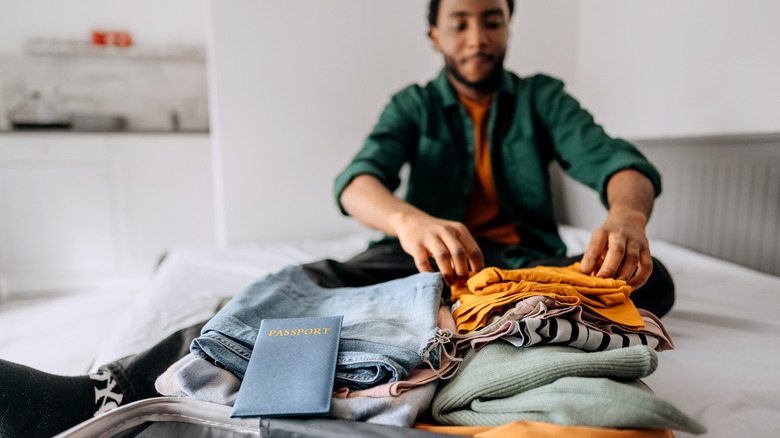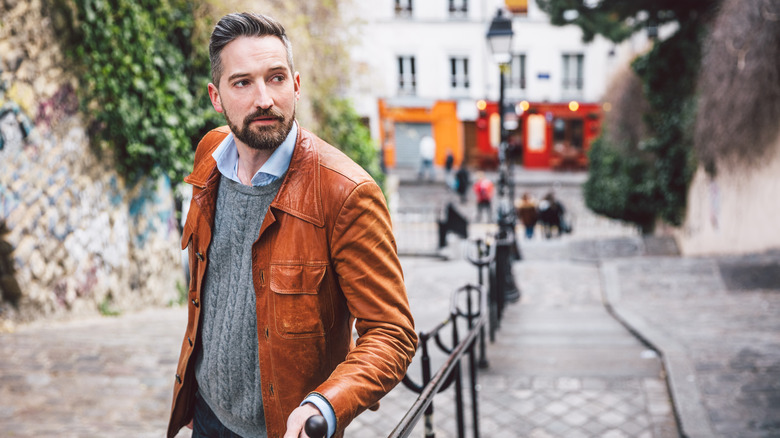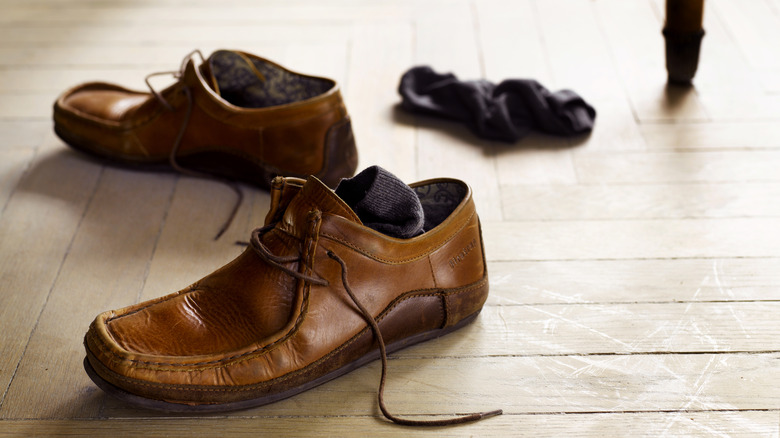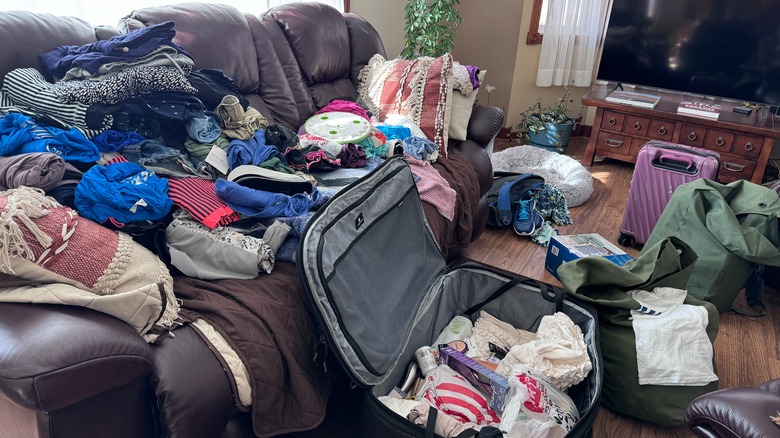Rick Steves' Son Says To Leave These Common Clothing Items At Home On Your Trip To Europe
If you've ever planned a trip to Europe, chances are you probably referenced a Rick Steves' Europe guidebook. He's helped countless tourists plan their dream trips by providing information on everything travel-related — including packing lists to help ensure tourists are well prepared for their adventures abroad. Now, a new generation of globe-trotters are turning to his son, Andy Steves, for travel (and fashion) advice.
Right after graduating in 2005, Andy Steves embarked on his first big European adventure. He had the expert himself help him and his friend, Alex Matteson, formulate his packing list. "Alex and I had a meeting with my dad to discuss our packing lists," he wrote on Rick Steves' website. His list included cargo khakis, running shoes, hiking sandals, flip flops, and a few other items he would probably advise travelers to leave at home today. Some core aspects of Andy's packing list have remained the same, but he now considers European fashion trends and avoids packing items that might make him stand out as a tourist.
Rick Steves encourages travelers to "just dress in a way that makes you comfortable. No matter how carefully you dress, your clothes will probably distinguish you from Europeans. And so what? To blend in and be culturally sensitive, I watch my manners, not the cut of my clothes." Andy Steves prefers to pack more intentionally so as not to commit a fashion faux pas" while traveling in Europe. Now in his late 30s, Andy Steves has cemented himself as a travel expert and has some packing tips of his own, which he outlined on his website, Andy Steves Travel. If you're wondering how to look like a local when traveling in Europe, he has some great advice on what to pack and what to leave at home.
Ditch the athleisure and the shorts
Some foundations of Andy Steve's packing techniques haven't changed drastically since his post-graduation Europe trip, but his personal taste and style have. He still packs plenty of underwear so that he doesn't have to visit the laundromat very often, but you probably won't catch him in the cargo khakis and lightweight shorts of his youth.
Tourists need to be mindful of the clothing they pack on a trip to Europe if they don't want to stick out like a sore thumb. According to Andy Steves, there are some things you should definitely leave behind if you want to avoid looking like a tourist. When traveling in Europe, you may notice that some common clothing items worn in the United States are missing from the locals' wardrobes. If you're not careful, you could immediately stick out to the locals the second you set foot on the European continent.
Andy suggests leaving your shorts at home unless you'll be hanging out by the beach. "It may seem crazy, but many Europeans hardly ever wear shorts unless they're physically on the beach or at the pool," he wrote. In a video posted on Facebook, he added that no matter the temperature or season, he's noticed that everyone wears long, dark-colored pants in European cities.
Wearing athletic or outdoorsy clothing is another dead giveaway that you're an American tourist. According to Andy, you shouldn't pack your North Face fleece jacket, no matter how cozy it may be. Remember – you're in Europe, not on a camping trip. Other sporty clothing, like jerseys representing football or basketball teams and baseball caps, is also a no-go.
Pack dark and neutral colors instead of pastels
Pants are an ideal choice when visiting Europe, but you might want to reconsider packing blue jeans — especially if they're overly distressed. Andy suggests packing a nice pair of dark-wash denim pants instead. They can work well for a variety of occasions, including a nice dinner out. "I make sure they're light material if I'll be in Europe over the summer," he wrote on his website. If you're in search of a good lightweight pair of pants that won't be too hot on a warm day in Rome, consider linen or cotton trousers.
To avoid looking like "frat boys at the U Alabama football game," as Andy bluntly explained, you should avoid wearing pastel colored clothing, including shorts, shirts, and pants. On the topic of clothing color, father and son are aligned. In an article about packing tips that Rick Steves wrote for his website, he said, "neutral colors (black, navy, khaki) dress up easily and can be extremely versatile. No one knows you're wearing the same outfit every third day...except your travel partner, and they're doing the same thing."
In the United States, college students and alumni often show off their school spirit by wearing university-themed clothing and accessories. Europeans take pride in their academic accomplishments, but they don't usually advertise them on their clothing. Andy says that you should skip packing college-branded apparel.
Choose a fashionable and comfortable shoe
A pair of uncomfortable shoes can ruin a day of sightseeing, but a pair of flip flops can ruin an otherwise stylish outfit. Flip flops are actually banned in some European destinations. Although the bans aren't strictly enforced, it's still a good idea to avoid packing casual sandals unless you're going to the beach. If you're not embarking on strenuous hikes or working out in the hotel gym, it's also best to leave the hiking boots and athletic sneakers at home. "If you're visiting Europe for the first time, it's likely you'll be sticking to urban destinations, and as long as your shoes don't cause you blisters, there's no need for hiking boots on the streets of Paris," he wrote. Boat shoes, like Sperry's, aren't the right vibe either, and Andy recommends leaving them behind.
You'll want to strike the perfect balance between comfort and style when it comes to footwear, and make sure your shoes won't give you blisters. "Whatever you do, do not pick up a pair of leather loafers and bring them to Europe without breaking them in," Andy wrote. "I stick to "fashion sneakers" for shoes, i.e., shoes that I can dress up a bit with a button-up and dark wash jeans at night, or wear the same pair with a much more casual outfit in the day."
Keeping your feet clean and well cared for is also one of Andy's top priorities, so he never forgets to pack plenty of socks. "Funky socks make for funky shoes, and there's nothing worse than grimy, smelly shoes while on the road. Keep your socks clean, and your shoes will follow suit," he wrote.
Leave behind the extra stuff
One tip that Andy Steves stresses on his website is that you should avoid overpacking. He warns against purchasing a "whole new wardrobe" before your trip and encourages travelers to stick to the basics. "The bottom line is to remember that no matter what you lose or forget along the way, you can always find another in Europe. While it won't be the exact brand or packaging you're used to, nearly 750 million people live their entire lives in Europe—whatever you may need, they have it," he wrote.
If you're thinking about buying something new for your trip, consider opting to find it in Europe instead. Shopping is a fun excuse to explore European cities like a local. Plus, you'll be able to pick up some unique souvenirs to commemorate your trip and potentially even elevate your travel wardrobe. "Besides the requisite warm jacket or new pair of shoes, you're better off under-packing so you can pick up some sweet Euro-styles while abroad. Inevitably, you'll want to shop at least a little bit in Europe, and if you start your travels with a full suitcase, how are you going to fit your new swag?" wrote Andy.
Andy suggests spending a few days checking out the local styles before you start buying new clothes. He suggests that you "find out where the locals shop so you can blend in better." If you're looking to score some good deals, he suggests checking out the local sales. "Italy, for example, has great semi-annual sales in January and August to get rid of old inventory."




